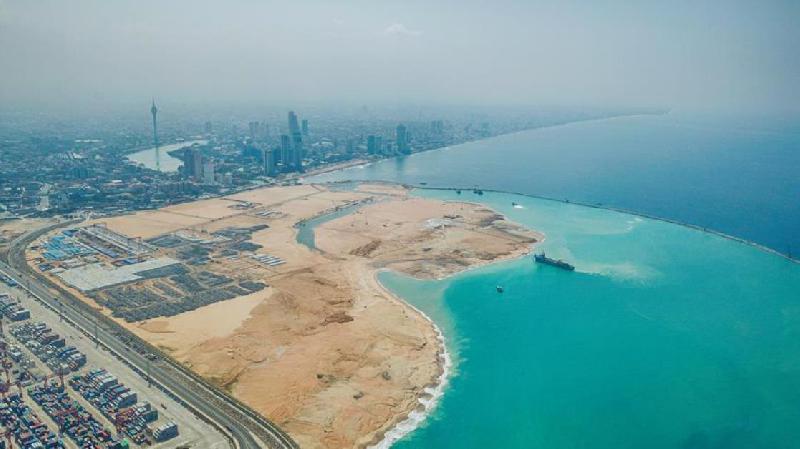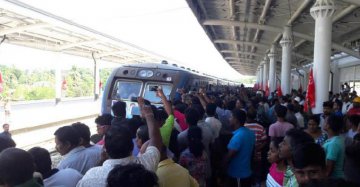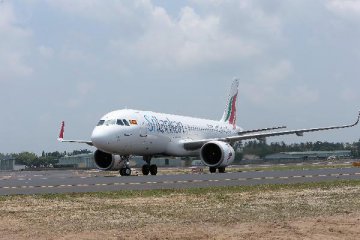
For Sri Lankan engineer Sanjeewa Alwis, a veteran of the Colombo Port City project, the scene of four state-of-the-art Chinese dredging vessels pumping yellow sea sand is more than impressive.
With the reclamation of land completed, the Chinese-funded Port City under construction near the Colombo Harbor is beginning to take shape. It will soon be ready for maritime structures and further infrastructural construction.
A mechanical, electrical and plumbing manager of the project, Sanjeewa said it was not easy to push forward the development only years ago.
He still vividly remembered that in May 2017 he "shared (his) story of building the Port City project and asking the Sri Lankan government for a backup water supply inlet" at a Belt and Road forum in Beijing.
The Colombo Port City has gradually but increasingly gained popularity in the island country, with many looking forward to making use of the facilities.
"We need to understand each other first, and bond our hearts together," Sanjeewa said. "Luckily, Sri Lanka and China have achieved that in the project of the Port City."
LAND RECLAMATION COMPLETED
On reclaimed land adjacent to the commercial district of Colombo, the Port City is co-developed by the Sri Lankan government and China's CHEC Port City Colombo (Pvt) Ltd, a subsidiary of China Communications Construction Company Limited (CCCC). It aims to be a commercial, financial, residential and international entertainment hub in South Asia.
At a ceremony held earlier this month marking the completion of land reclamation, officials said that 269 hectares of land were reclaimed from the sea.
The project is a technological marvel and one of the most spectacular development projects Sri Lanka has ever had, said Minister of Megapolis and Western Development Patali Champika Ranawaka.
"Sri Lanka is going to be the center of change in the next few years and the Port City is going to be one of the most vital projects in getting us there. The city is going to make Sri Lanka the center of South Asia," the minister said at the event.
Construction of the Port City started in September 2014 and is expected to take 25 years. The project is also part of the China-proposed Belt and Road Initiative (BRI), put forward in 2013 with the aim of building a trade and infrastructure network connecting Asia with Europe and Africa.
The project "symbolizes that the friendship between China and Sri Lanka runs a long history and is worth more than the value of the investment," Chinese Ambassador Cheng Xueyuan said at the ceremony.
With advanced concepts, rigorous technology, and a corporate culture of teamwork, this project will boost Sri Lanka's socioeconomic development and improve local living standards, said the Chinese envoy.
SHINING PEARL OF INDIAN OCEAN
The 1.4-billion-U.S. dollar Port City is Sri Lanka's largest foreign direct investment, and the largest Belt and Road project in Sri Lanka.
The Port City has created more than 4,000 local jobs, and in the next 20 years of the project, a total of 83,000 jobs are expected, according to the Chinese ambassador.
Local employees said the project has provided not only jobs but higher salaries and a better life.
The total Gross Floor Area will be up to 5.73 million square meters, comprised of residences, hotels, offices and retail space, and other iconic developments such as a theme park, a yacht marina, a central park, a medical center, an international school and a sand beach, according to CCCC Chairman Liu Qitao.
"These will attract further 13 billion dollars investment of property developments within the city," Liu said.
He believes the Port City will help Sri Lanka attract not only foreign investment, but also international talent and advanced technology.
In April last year, the Sri Lankan government approved the Port City's Development Control Regulations, allowing for further investments.
"We have been to Southeast Asia, the Middle East and many regions in the world to attract investment for the Port City," said Liang Thow Ming, chief sales and marketing officer from CHEC Port City Colombo (Pvt) Ltd. "About a dozen international enterprises have expressed interests in the project."
ENVIRONMENTAL GUIDELINES OBSERVED
Environmental protection rules have been strictly observed during the sand mining operation, Zhou Zhongpan, captain of Xin Hai Long, a trailing suction hopper dredger in the construction fleet, told Xinhua.
A dredging area, or an excavation area, is usually located 7.5 km from coastlines to minimize its impact on local ecosystem and the marine creatures in particular, he explained. In the pumping area, sediment barriers were introduced to protect the environment before a breakwater was built.
Nearby residents were initially concerned about the possible impact of the mega-project on their communities, said Noorul Aleem, senior engineer of the Port City project's Health, Safety and Environment (HSE).
Local authorities, however, worked meticulously to ensure that all environmental requirements, such as air quality, noise, vibration and water quality, were properly met by the contractors.
"Now local residents are convinced that the Port City will fully benefit the country's economy without harming the environment," the engineer said.
According to Ranawaka, the minister, 26 government agencies and environmental monitoring teams were appointed to oversee the Port City project and its environmental impacts.
Rawa, a vendor who sells kites at Colombo's Galle Face Green park close to the Port City, has witnessed the Chinese dredgers pumping sand into the air almost every day since the reclamation started in October 2016.
He said he "will miss" the scene, after learning the dredgers will soon leave. "Anyway, the Port City will benefit my children in the future."




















Latest comments